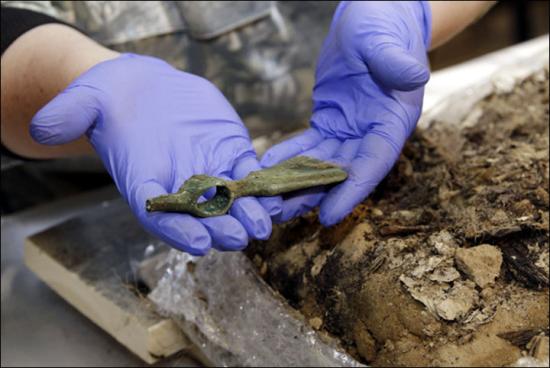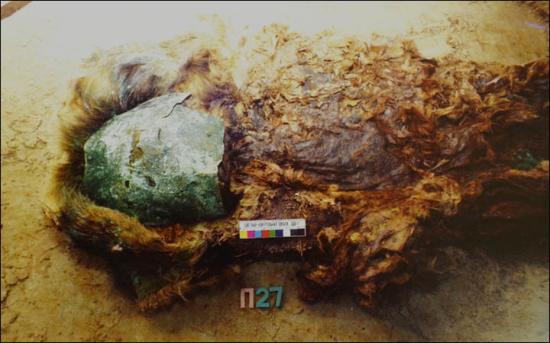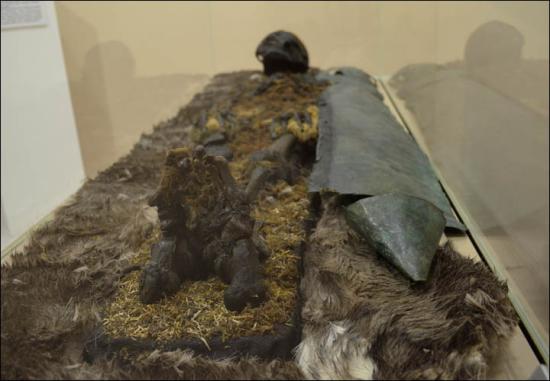PART.2
'At the moment, a second MRI scan is underway to detect more details.'


The items found with the body - the axe, pendant and rings - suggests 'this was not some poor boy'. Pictures: Yamalo-Nenets regional Museum and Exhibition Complex
Scientists say the mummification at this site was 'accidental': it was not intended by this ancient clan, but happened because of the copper and permafrost. The boy's remains were dug up several weeks ago, but only now opened in Salekhard. It is the first mummy from the civilisation found at this intriguing site since 2002.
'The birch bark 'cocoon' is of 1.28 metres in length and about 30 cm at the widest part', said Dr Gusev. 'It follows the contours of the human body.' Iniitally they suspected a teenagers remains lay inside the birch bark, but when opened it is clear the child is much younger.
Previously, archeologists found 34 shallow graves at the medieval site, including 11 bodies with shattered or missing skulls, and smashed skeletons. Five mummies were found to be shrouded in copper, while also elaborately covered in reindeer, beaver, wolverine or bear fur. Among the graves found so far is just one female, a child, her face masked by copper plates. There are no adult women.
X
Five mummies were found to be shrouded in copper, while also elaborately covered in reindeer, beaver, wolverine or bear fur. Pictures: The SIberian Times, Natalya Fyodorova
Nearby were found three copper masked infant mummies - all males. They were bound in four or five copper hoops, several centimetres wide.
Similarly, a red-haired man was found, protected from chest to foot by copper plating. In his resting place, was an iron hatchet, furs, and a head buckle made of bronze depicting a bear.
The feet of the deceased are all pointing towards the Gorny Poluy River, a fact which is seen as having religious significance. The burial rituals are unknown to experts.
Artifacts included bronze bowls originating in Persia, some 3,700 miles to the south-west, dating from the tenth or eleventh centuries. One of the burials dates to 1282, according to a study of tree rings, while others are believed to be older.
The researchers found by one of the adult mummies an iron combat knife, silver medallion and a bronze bird figurine. These are understood to date from the seventh to the ninth centuries.
Unlike other burial sites in Siberia, for example in the permafrost of the Altai Mountains, or those of the Egyptian pharaohs, the purpose did not seem to be to mummify the remains, hence the claim that their preservation until modern times was an accident.

Similarly, a red-haired man was found, protected from chest to foot by copper plating. In his resting place, was an iron hatchet, furs, and a head buckle made of bronze depicting a bear. Pictures: Kate Baklitskaya, Go East
The soil in this spot is sandy and not permanently frozen. A combination of the use of copper, which prevented oxidation, and a sinking of the temperature in the 14th century, is behind the good condition of the remains today.
Dr Fyodorova, of the Ural branch of the Russian Academy of Sciences, said previously: 'Nowhere in the world are there so many mummified remains found outside the permafrost or the marshes.
'It is a unique archaeological site. We are pioneers in everything from taking away the object of sandy soil (which has not been done previously) and ending with the possibility of further research.'
In 2002, archeologists were forced to halt work at the site due to objections by locals on the Yamal peninsula, a land of reindeer and energy riches known to locals as 'the end of the earth'.